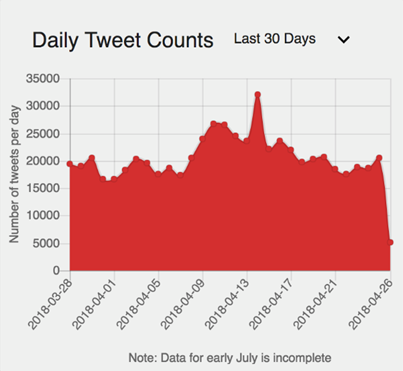As the United States, Britain, and France launched targeted airstrikes against suspected chemical weapons sites in Syria on April 13, U.S. Secretary of Defense James Mattis predicted that there would be “a significant disinformation campaign over the coming days by those who have aligned themselves with the Assad regime.”
Data collected by Hamilton 68, an online dashboard that tracks the messaging of roughly 600 Russian-linked accounts, revealed a significant spike in pro-Kremlin activity in the aftermath of the strike, lending credence to Mattis’ prediction. On April 14, accounts monitored on Hamilton 68 tweeted 33,139 times, a 35 percent increase from the day before and an 85 percent increase from the previous Saturday. While this increase was far less than the “2,000 percent increase in Russian trolls” noted by the Pentagon,[1] it was the most activity recorded in any 24-hour period during the previous 30 days, and one of the most active days of posting since the launch of the dashboard in August 2017. The surge in activity was notable not only for its volume but also its focus. The day after the strikes, #Syria was by far the most-used hashtag by monitored accounts, and seven of the ten most linked-to URLs on Hamilton 68 focused on either the allied campaign or the chemical weapons attack in Douma. Also of note were the two most linked-to domains: Kremlin-funded outlets RT and Sputnik.
This represents a shift from the weeks and months prior (with the notable exception of activity around the poisoning of Sergei and Yulia Skripal in the U.K.), when American issues were the primary focus of the network’s tweets and geopolitics played a secondary role. In January, for example, less than 10 percent of the top URLs focused on Syria, with the so-called “release the memo” controversy and partisan political content dominating the top URLs section on the dashboard. And while RT and Sputnik were among the ten most linked-to domains during the month, they were less prominent than several hyper-partisan U.S. sites, and the messaging patterns during this period were far more fungible. Both the Skripal case and the Douma attack suggest that when Moscow perceives a direct threat to its interests, Russian-linked accounts shift to not only overtly pro-Kremlin messages, but also pro-Kremlin messengers.

Daily Tweet count showing spike in pro-Kremlin activity after the allied strikes
The Kremlin’s Long Game
While the focus on Syria has intensified since the Douma attack, Moscow’s efforts to influence Western public opinion are as old as the conflict itself. Since the earliest days of Russia’s involvement in Syria, pro-Kremlin trolls have amplified anti-Western and pro-Assad narratives, attacked critics, and promoted conspiracy theories in an effort to undermine Western resolve. Hamilton 68, in fact, is in many ways a byproduct of the Syrian war — many of the accounts monitored on the dashboard were first identified by counterterrorism analysts who discovered them almost accidently while monitoring ISIS propaganda in Syria.
Over the past eight months, results from the dashboard have highlighted the centrality of Syria in Moscow’s information war with the West. While American wedge issues — from NFL protests and gun control to the Mueller investigation — have, for the most part, proven to be transient, pro-Kremlin Syrian narratives have been ever-present, as evidenced by the fact that #Syria has been the most-used hashtag by monitored accounts since the launch of the dashboard. The activity following the allied strike must therefore be viewed as a continuation, albeit certainly an escalation, in a prolonged campaign of influence.
The near-constant insertion of anti-Western narratives related to Syria has also conditioned American audiences to be more receptive to the specific narratives that have emerged in the wake of the Douma attacks. This has been most directly evidenced by the sustained campaign to discredit the White Helmets, a group that has become a bête noire of sorts for Moscow. Long before the White Helmets were accused by pro-Kremlin media of staging the Douma attacks, they were routinely presented as a nefarious, Western-backed group running cover for anti-Assad terrorists. The seeds of disinformation were thus planted in advance and merely harvested at an opportune time.
Less direct, but equally effective, has been the consistent promotion of conspiratorial content writ large. This has been most readily visible after mass shootings, when Russian-linked accounts have pushed false flag narratives that suggest that the U.S. government is willing and able to stage mass murders in the pursuit of certain policy objectives. If targeted audiences have been conditioned to accept that the United States is capable of such acts on domestic soil, it certainly would be conceivable to think that the U.S. government would condone similar activity overseas.
Russian-linked online activity over the past few weeks therefore needs to be understood as both a unique event, and one that is entirely consistent with long-term efforts to engage American audiences. Influence requires a long, sustained effort, and the Kremlin has proven to be willing and able to play the long game.
Report was amended in November 2018 to reveal new statistics for Twitter activity on April 14. The correct number of posts was 33,139, not 32, 083, as first reported.
The views expressed in GMF publications and commentary are the views of the author alone.




